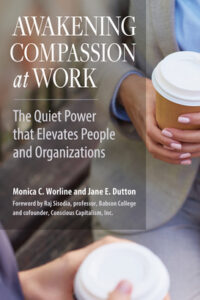Awakening Compassion at Work
Someone once told me that if you treat everyone as if they are suffering in some way, you will be right most of the time.
Throughout my life, I’ve remembered the wisdom in this advice. Some leaders have told me that work is a place where you focus on business results and anything else is a waste of time. How short-sighted and wrong.
Suffering in the workplace is a reality and a natural part of life. It’s an unquantified drain on productivity. It can prevent people from doing their best.
Monica C. Worline, Ph.D., is founder and CEO of EnlivenWork, an innovation organization that teaches compassionate leadership. She is a research scientist at Stanford University’s Center for Compassion and Altruism Research and Education, and she is the executive director of CompassionLab, the world’s leading research collaboratory focused on compassion at work. Monica holds a lectureship at the Ross School of Business, University of Michigan, and is an affiliate faculty member at the Center for Positive Organizations. She and her colleague Jane E. Dutton, Ph.D., are co-authors of the new book Awakening Compassion at Work: The Quiet Power that Elevates People and Organizations.
I recently spoke with her about compassion at work.
Compassion at work isn’t something we typically think about, but we should. Tell us more about your research and findings about compassion at work.
It’s true, Skip, we do need to think more about compassion at work—especially if we care about generating great business results—because over the past fifteen years, my co-author Jane Dutton and I have been doing research that demonstrates that compassion is central to human-based capabilities in organizations. As a CEO yourself, I’m sure you are aware that there is an epidemic of disengagement and despair at work. By some measures, up to 70 percent of people don’t feel like anyone cares about them when they go to work every day. That leaves them emotionally out in the cold. They may physically show up, but psychologically they’re checked out. Compassion is an overlooked, undervalued essential asset in today’s workplace.
Why is compassion at work so important?
 In our bookAwakening Compassion at Work, we offer a full business case for compassion as a source of strategic advantage for organizations. This is something many business leaders haven’t considered, but there is now reliable evidence from a variety of disciplines of research to support that compassion fuels the capability for high-quality service delivery, better innovation, collaboration, and adaptation to change. Compassion at work helps an organization retain its most talented people and its most valuable clients—that’s why it is so important for leaders like yourself. But on the human side of work, let me be quick to add that many people still carry around the myth that suffering should be kept outside of the workplace, and it’s really important to challenge that myth. The reality is that work is suffused with suffering—both brought in from home and created within the workplace—and compassion is the answer to helping to heal this suffering. But left unacknowledged and unaddressed, suffering robs workplaces of humanity, dignity, and motivation.
In our bookAwakening Compassion at Work, we offer a full business case for compassion as a source of strategic advantage for organizations. This is something many business leaders haven’t considered, but there is now reliable evidence from a variety of disciplines of research to support that compassion fuels the capability for high-quality service delivery, better innovation, collaboration, and adaptation to change. Compassion at work helps an organization retain its most talented people and its most valuable clients—that’s why it is so important for leaders like yourself. But on the human side of work, let me be quick to add that many people still carry around the myth that suffering should be kept outside of the workplace, and it’s really important to challenge that myth. The reality is that work is suffused with suffering—both brought in from home and created within the workplace—and compassion is the answer to helping to heal this suffering. But left unacknowledged and unaddressed, suffering robs workplaces of humanity, dignity, and motivation.
How to Respond to Suffering
Suffering makes many uncomfortable, and our response to it varies dramatically. Do you have any stories to share of someone who did this right?
This is true – the word ‘suffering’ itself makes us want to turn away. Jane and I have spent our entire careers gathering stories from people who have participated in compassion, received it, or witnessed it at work as it happened around them. One of the most impactful stories comes from the president of a university whose son had committed suicide. Of course, he and his family were changed forever by this tragedy. He made a vow to never be silent about suicide again. So, when he assumed the role of president of the university and there was a suicide on campus, he felt moved to speak publicly. He wrote a beautiful, self-revealing letter to the entire organization talking about why it was important for all of them to respond, to take care of one another, and to get educated about this form of suffering in their organization.
That’s a really dramatic example. Others are more subtle. Just last week I had a long conversation with a product manager in a technology firm who had warned a team about launching a new system because of the potential for a big bug and a lot of costly downtime – but they went ahead and launched it anyway. It turned out that the big bug was there. There was an immense cost of downtime to the firm, and the team that launched it was being vilified by others. This product manager, even though he had warned them not to launch, began to gather data about the bug and the potential fixes and rallied others to help. He said to them, “The water is under the bridge. We are all still part of the same organization and now we have to row together.” This kind of generous interpretation of a failure, and the action to alleviate the suffering that it causes as well as to fix the problem, is a different form of compassion at work.
Is it also generational? It seems that Millennials are driving some of this change and that some previous generations would find it startling.
Well, there is some strong evidence that the current generation of employees and career seekers are demanding different kinds of things in their work environments, including more flexibility and more humanity. So that’s for the good—because human workplaces that acknowledge both joy and suffering are also likely to be great workplaces.
But in our research, we have found pockets of compassion in many kinds of organizations, across all kinds of industries, and in many different demographics. So compassion may be flying “under the radar” of the leadership writers and bloggers, but in fact it has been one aspect of any great leader’s approach to his or her people for as long as great leaders have been around.
Cultivate Empathy in Your Organization
Let’s talk about empathy. Can you cultivate it in individuals and in organizations?
I love talking about empathy—and the short answer is yes. The research evidence in both neuroscience and psychology shows that you can cultivate empathy. In fact, the more that people hold the belief that their empathy can grow with practice, the more it grows.
The longer answer, that we address more in the book, is that empathy is only one part of compassion. Compassion is actually a 4-part human experience. Compassion always begins with noticing suffering—an attentional component—and then interpreting that suffering as relevant to work and worthwhile for us to respond. Then comes empathy—a form of concern for the other person’s well-being, which motivates action to alleviate suffering, which is the fourth part of compassion at work.
Lead with Compassion
You point out that we look to leaders in times of suffering. What are some of the ways leaders should work to develop a culture of compassion competence?
We talk to leaders about two things: first, leading WITH compassion—which reminds us that we are all role models for someone. People emulate leaders, so it’s important in a culture of compassion that leaders visibly act with compassion in ways others can emulate.
Second, we talk about leading FOR compassion, which means paying attention to how every decision, policy, and practice is creating—or blocking!—compassion in your organization. We offer design principles to help leaders with this. But if you want a culture of compassion competence, everything you do can be infused with compassion.
What are some ways an entire organization can awaken compassion?
Let me give you four quick things you can do. First, revisit the values in action in the organization, especially the ones related to human beings. Are you assuming that people are essentially good and capable and that they are worthy of compassion? How does this show up in your organization?
Second, look at the network structures. Who’s included and who’s excluded? Are there ways that people feel seen and known at work?
Third, re-examine the roles in your organization and see if you can define them all in relation to compassion. It’s possible—it just requires that you and your team challenge yourself to do it.
Fourth, look at every routine—the way tasks get accomplished between people—and see if you can imagine doing it with greater compassion. This will spread compassion far and wide in your organization!
With cultural differences, it’s important to think about this globally. How does compassion and the views of suffering differ across the globe?
Cross-cultural research has documented that compassion is part of many systems of human value or virtue as well as embedded in many spiritual and religious traditions around the globe. While, of course, each culture will have nuances in its expression of compassion and in the obstacles to compassion—and it’s important to learn about these in order to build our cultural intelligence—compassion is universal because human suffering is universal and, at its heart, compassion is the human response to suffering.
For more information:
Awakening Compassion at Work: The Quiet Power that Elevates People and Organizations
